While dating back over 500 years, the old saying “too much of a good thing can be bad” is no less true today, especially concerning dopamine.
Commonly praised as the “reward drug” for its role in motivating us to achieve pleasure from rewards, dopamine is one of the primary motivators of the brain. When utilized efficiently, dopamine facilitates great motivation and energy to overcome challenging tasks. When abused, however, it can quickly become our most prominent barrier against productivity.
In this article, we’ll explore the concept of a “dopamine reset”, often commonly misleadingly referred to as a “dopamine detox” or “dopamine fast”, and how this transformative technique can empower you to seize control of your brain’s reward system, realign your motivation, and supercharge your performance.
What is Dopamine?
Dopamine is a neuromodulator – a chemical compound that influences the modulation of many other neurons. You can think of it as a messenger molecule in the brain that allows specific nerve cells to communicate with one another.
Dopamine is one the key players in the brain’s performance systems, alongside norepinephrine (essential for alertness, arousal, and vigilance), acetylcholine (crucial for learning, memory, and muscle function), serotonin (associated with mood regulation and emotional stability), and many more. Together, these chemicals create a synergy of motivation, emotional regulation, pleasure, and well-being.
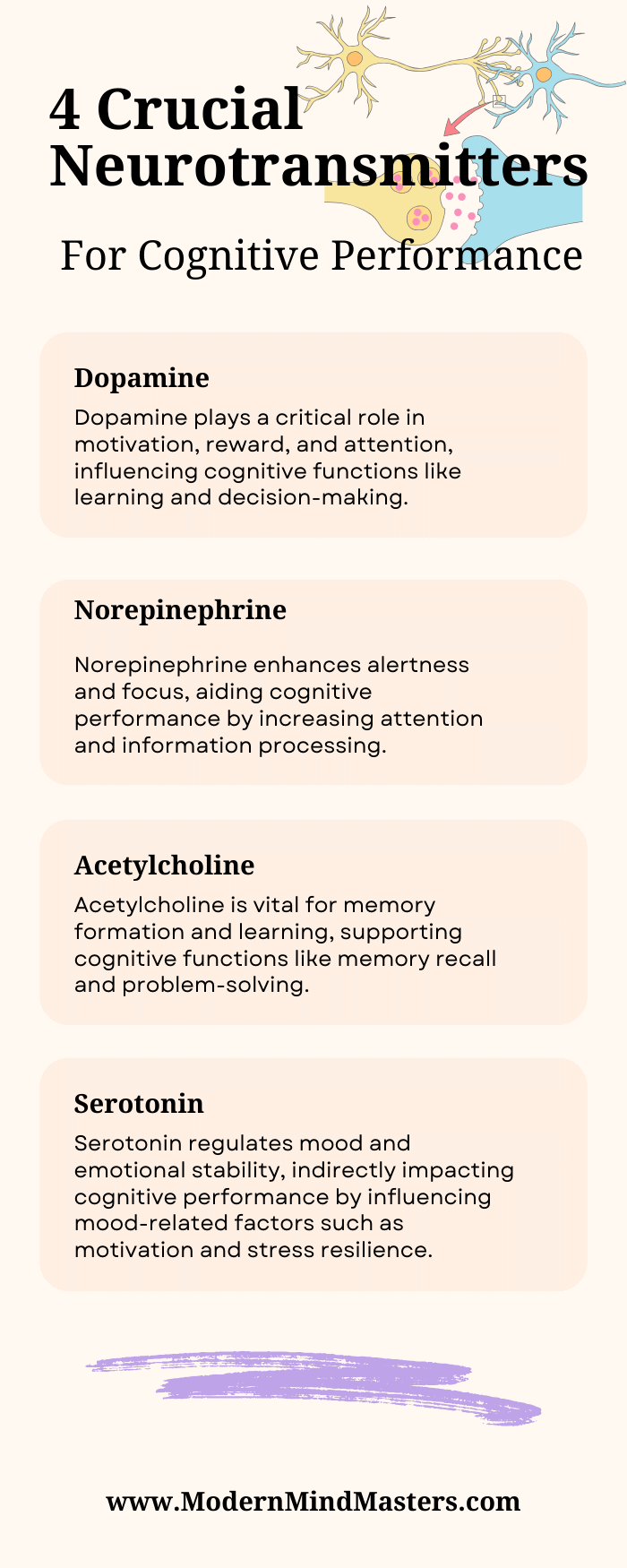
The Dopamine Reward System
One of the primary roles of dopamine is the dopamine reward system, often referred to as the brain’s reward pathway, a complex neural circuit that plays a central role in reinforcing behaviors associated with pleasure and reward.
In simple terms, dopamine induces the effort needed to overcome mental resistance. When you don’t want to work out, the release of dopamine, through the anticipation of pleasure or reward (such as a treat for completing the workout), creates the mental energy (willpower) needed to overcome this initial resistance. As a result, we feel motivated and driven to achieve a goal despite the short-term pain.
Through neuroplasticity, the brain begins to learn and predict when a potential “hit” of dopamine is coming. For those who have coffee or smoke a cigarette every morning at 8 a.m., the brain will learn to expect the dopamine spike at 8 a.m. and begin to crave it every morning.
While we can use this for good, such as using the reward of a nice cup of coffee after achieving our daily goal of reading 30 pages of a book, it can also be detrimental, such as encouraging cravings for cigarettes.
The Negative Effects of Too Much Dopamine
Seeing as dopamine creates spikes that boost motivation and pleasure in expectation of a reward, one might logically say that more dopamine results in greater motivation. Unfortunately, biology has limits, and too much dopamine will likely prove not only unproductive but dangerous.
1) Dopamine Abuse Leads to Lessened Pleasure and Motivation
What determines the intensity of the dopamine spike (the magnitude of pleasure resulting from it) is the difference between your baseline level of dopamine (the natural background level of dopamine in your system) and the peak of the dopamine spike that occurs when doing something pleasurable, as shown on the dopamine chart below.
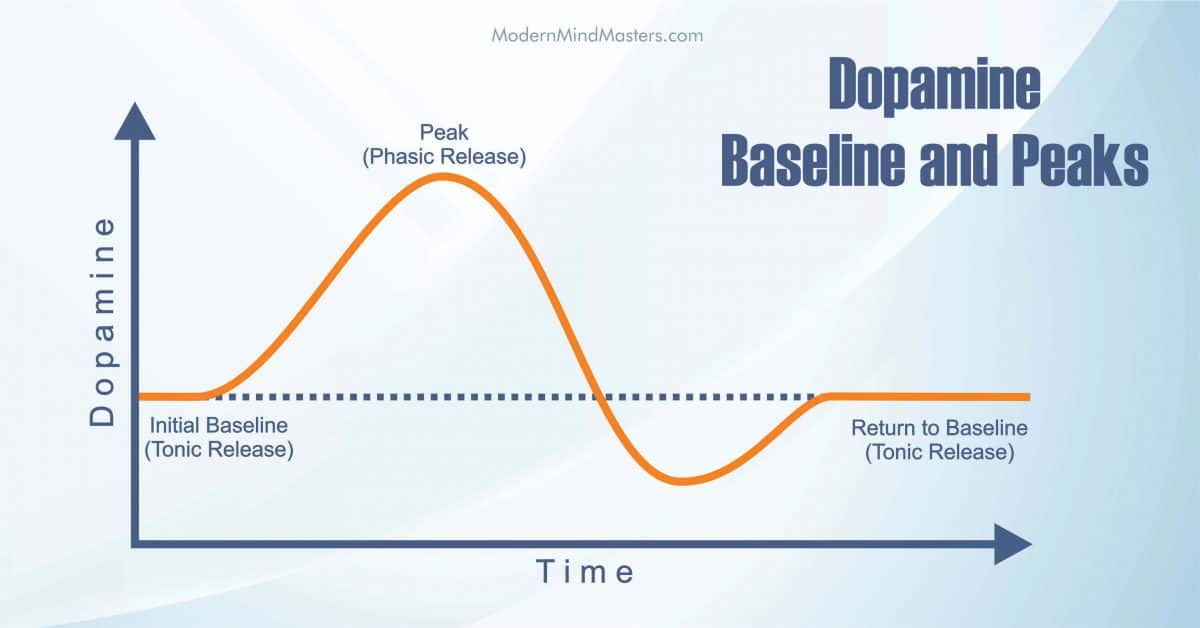
As shown in the dopamine chart above, dopamine levels take time to increase and decrease, meaning there is a delay in reaching the peak and the subsequent return to baseline.
When we perform dopamine-spiking activities too frequently, that is, we repeat them before our dopamine levels can reset back to the baseline level, and the size of the next dopamine spike will be smaller, even for the exact same activity. As a result, the amount of pleasure experienced from the same activity will be less than if we were to perform it from our baseline level.
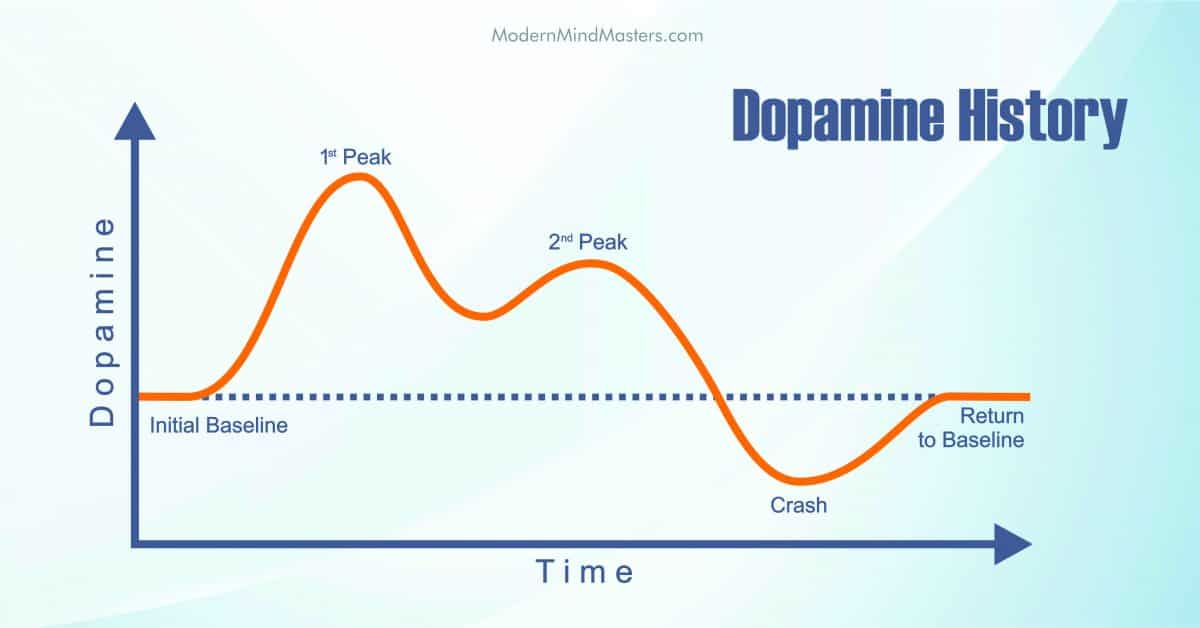
This is the most significant problem with constantly spiking our dopamine levels; by not allowing them to reset back to baseline, any future dopamine spike will not result in as much pleasure or motivation. The more frequently we spike it, the less pleasure we feel from each spike.
2) Dopamine Leads to Addiction and Substance Abuse
A second serious issue with spiking our dopamine too intensely or frequently is that we can never achieve the same intensity of pleasure and motivation as when we first performed the activity. As a result, we chase the same feelings with higher intensity or frequency, which can lead to addiction and substance abuse.
Videogames are a prime example. When first playing that brand new game you’ve been waiting months to play, the pleasure of playing it is high. While you may enjoy playing it for four hours a day for the first week, it will slowly become less pleasurable as time passes until it no longer stimulates much pleasure, and you move on to a new game in search of the same high.
The game didn’t change, but the frequency with which you played it reduced the peak of the dopamine spike. The same is true for drugs, cigarettes, and alcohol, all of which have detrimental effects from frequent consumption.
3) Dopamine and Instant Gratification Reduce Productivity
We can use dopamine to help motivate us to achieve a goal, using the innate reward system for productivity. When we allow our dopaminergic cravings to follow their own desires, however, we end up stuck in an unproductive cycle of chasing instant gratification, leading to the enemy of productivity – procrastination.
This productivity paradox is more abundant today than at any other time in human history. Smartphones, the internet, and social media, while all productive tools when used diligently, can wreak havoc on our baseline dopamine levels, leaving us chasing highs that become increasingly harder to achieve.
Social media is designed to exploit this knowledge; developers know that the constant small dopamine dose from receiving likes, followers, or comments gives us just enough dopamine to keep us going, keeping us glued to our phones and increasing their engagement statistics.
But the more you chase it, the less pleasurable it becomes. The first video of the day you watch may be very pleasurable, but if you were to watch the same video after watching three before it, the same video would not elicit as much pleasure. As a result, you scroll and scroll, chasing that same high, but never quite find it.
Not only does this waste your time as you keep scrolling social media trying to chase another dopamine hit, but your dopamine baseline level will be artificially elevated, as it hasn’t had time to fully reset. As a result, any dopamine spike you may face will be smaller, meaning there is less motivation available for future tasks, opening the door to procrastination.
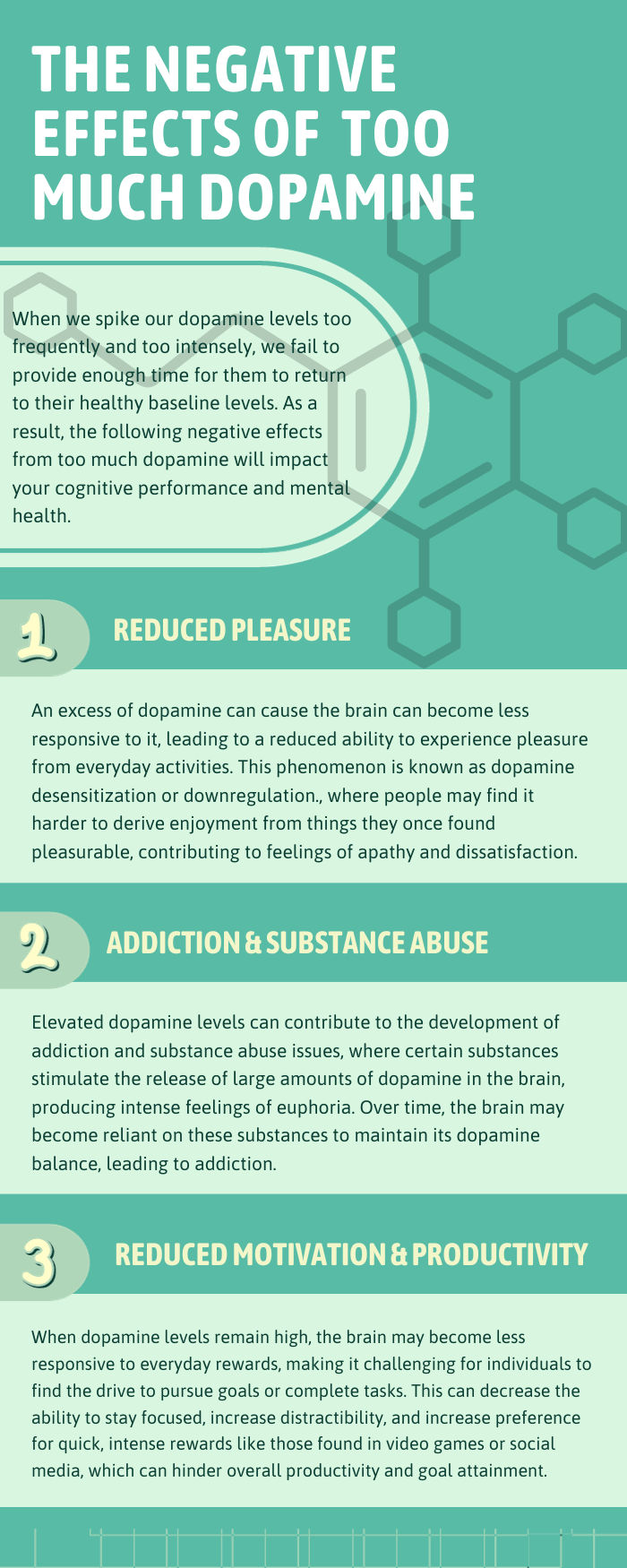
What is a Dopamine Reset?
A dopamine reset (also commonly referred to as dopamine detox or dopamine fast) is not a well-established or widely recognized scientific term or medical procedure, but it is a useful term to visualize resetting your baseline dopamine levels (background levels of dopamine present when not engaging in anything pleasurable) back to healthy and productive levels.
The Benefits of a Dopamine Reset
Having determined that the intensity of pleasure and motivation you can feel is a result of the size of the dopamine spike, that is, the distance between the peak and your baseline dopamine levels, and that too intense and too frequent dopamine spikes diminish your ability to induce dopamine and motivation in the future, it is clear that the only way to fix this is to regulate your baseline dopamine levels, what is referred to as “resetting” dopamine levels.
How to Reset Dopamine Levels
Resetting baseline dopamine levels back to healthy background levels revolves around reducing either the intensity of each dopamine spike (which reduces the time needed to return to baseline) or reducing the frequency of each spike (providing enough time for dopamine levels to return to baseline).
1) Reduce Your Use of Stimulants
Countless substances elevate dopamine levels by providing a quick boost of energy to overcome challenging tasks. Whether a cup of coffee to help start your working day or a pre-workout before hitting the gym, such stimulants have proved to be highly effective when used strategically.
But their strength can also be their weakness; they should be considered tools to enhance performance, not a requisite. Many (myself included) become so dependent on a cup of coffee in the morning that they cannot function properly until they get their fix.
Limit your use of stimulants to only those times when you need them. When working out in the gym, save the pre-workout for the one day a week when you need that extra boost. Keep the days random so the brain cannot get used to and expect a dopamine peak, enhancing the spike when you really need it.
Limit your use of dopamine-spiking substances to the point where they do not interfere with one another. Ensure enough time has passed to keep the brain and body guessing. Limit their use to once or twice a week, and keep their use on random days and times to avoid the body becoming accustomed to expecting it.
2) Keep Your Dopamine Hits Random
The more frequently we indulge in dopamine-inducing activities, the less of an effect they will begin to have. We should therefore seek to limit how often we indulge in them.
There is no set rule here – it depends on the individual as well as the activity – but the best practice is to keep your use of stimulants and any dopamine-inducing event random.
Avoid letting the body become accustomed to a particular activity or substance to avoid the brain predicting and expecting a dopamine spike. Take that pre-workout on Monday one week, and Wednesday and Friday the next. Ideally, you should limit its use to when genuinely needed.
By providing enough time in between spikes, you allow your baseline dopamine levels to return to their normal levels. And by keeping your body guessing, the effects will always be fresh without interference from your previous dopamine-inducing events.
The same applies to all other activities; from gaming to sex, keeping dopamine peaks intermittent, and keeping your brain from predicting and expecting them, will allow you to use each activity for its maximum benefit.
3) Avoid Layering Dopamine Peaks
Don’t pile on multiple layers of dopamine-boosting activities all at once. For instance, when hitting the gym, try not to overload your brain with too many sources of dopamine, like cranking up the music, downing a pre-workout drink, and chatting with your buddies simultaneously.
Your brain can get used to these massive, multi-layered dopamine rushes, and when it doesn’t get that usual cocktail, like going to the gym solo without the music and friends, you might feel less motivated than usual.
It’s not going to be a walk in the park to peel away these layers and reduce their frequency at first; you’re essentially kicking an addiction to those past dopamine-fueled experiences and the expectations they create.
But here’s the exciting part: once you succeed and learn to intermittently regulate your dopamine intake, you’ll find yourself experiencing greater pleasure, motivation, and determination without the subsequent crash. You’ll tap into newfound energy and drive, becoming less reliant on other activities and substances for your pleasure. This journey is your ticket to a more fulfilling and balanced life!
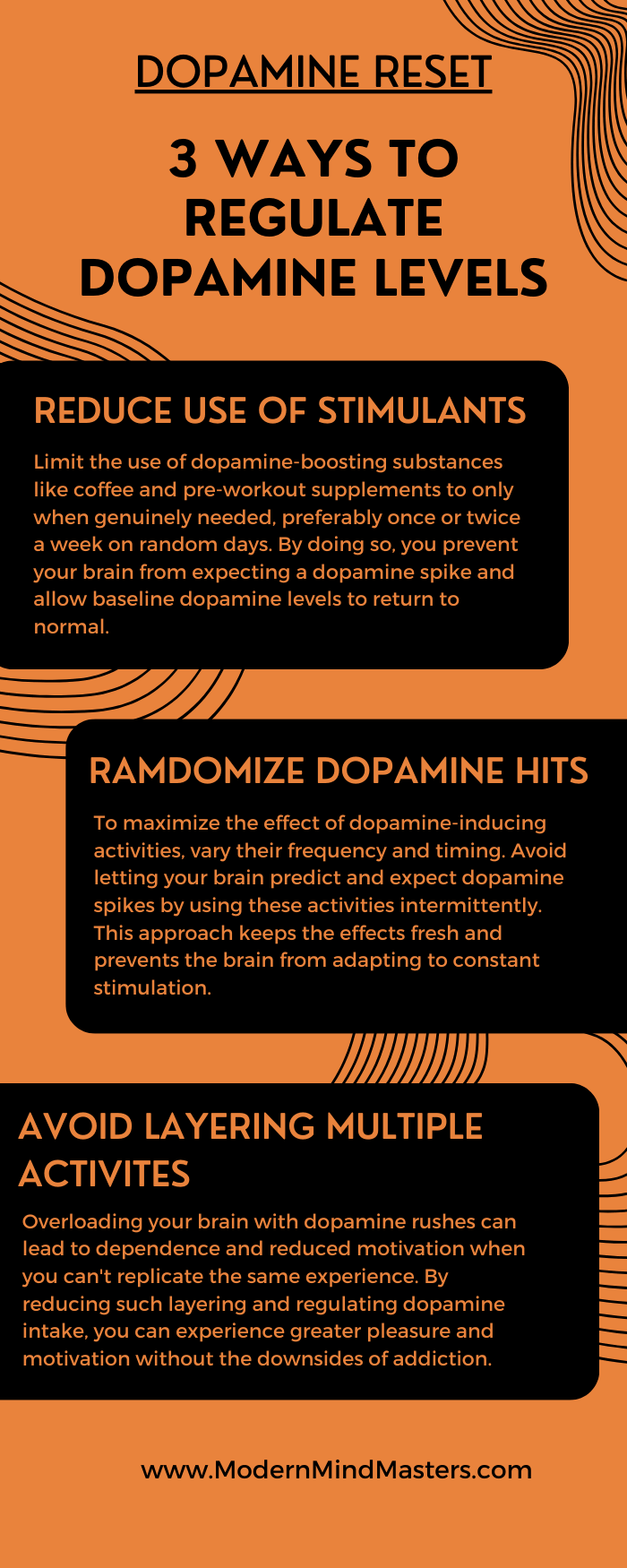
How Long Does it Take to Reset Dopamine?
The time it takes to “reset” dopamine levels in the brain can vary significantly from person to person and depends on several factors, including an individual’s habits and the extent of dopamine dysregulation.
When at your baseline level of dopamine, that is, at rest and unstimulated, dopamine can peak in as little as a few minutes, depending on the stimuli and their intensity. The return to baseline takes a little longer, anywhere from a few hours to a few days.
How long it will take to regulate your baseline dopamine back to healthy levels, however, varies greatly.
For those who struggle to concentrate on their work because of their habit of using social media, it might take a week or two of locking your phone in another room to regain your attention span.
For those whose overstimulation is greater, such as addiction to alcohol or chocolate, it may take a few months to a year to fully kick the habit and reset your baseline to a level where it no longer expects and predicts dopamine cravings.
While the theory is simple, the execution is anything but. Kicking addictions takes tremendous willpower and energy. It is unlikely you will be able to kick such bad habits cold turkey: your best bet is to slowly reduce how often you partake, and keep reducing it week by week until you reach a happy and healthy level.
Conclusion
The age-old wisdom that “too much of a good thing can be bad” holds, especially when it comes to dopamine, often hailed as the brain’s “reward drug.” While a powerful motivator, capable of driving us to accomplish challenging tasks when used wisely, misuse can soon turn it into a formidable barrier to productivity.
The negative consequences of excessive dopamine spikes, including reduced pleasure, motivation, and the potential for addiction, result from constantly spiking our dopamine levels. Without allowing time for our dopamine levels to return to their healthy baseline level, the sense of reward and motivation diminishes, leading to a cycle of chasing instant gratification and procrastination.
Resetting your dopamine levels, sometimes called a “dopamine reset”, can help you regain control over your brain’s reward system and boost mental performance, as long as you understand that the problem is not that we have too much dopamine, but that we perform dopamine-inducing activities too frequently and too intensely, without giving the time for our dopamine levels to return to a healthy baseline.
To regulate your baseline dopamine back to healthy levels, reduce your use of stimulants, keep your dopamine-inducing activities intermittent and unpredictable, and avoid layering multiple dopamine-boosting activities.
Ultimately, the journey to reset dopamine levels is a personal one, and the time required can vary widely. It may take days, weeks, or even months to regain control over the brain’s reward system and experience the benefits of a dopamine reset. It is essential to approach this process with patience and a gradual reduction of problematic habits.
While not easy, this journey of resetting your dopamine will certainly prove rewarding, unlocking a future filled with boundless motivation, genuine pleasure, and the power to conquer life’s challenges with renewed vigor and purpose.
FAQs
What is a dopamine reset?
A dopamine reset is not a well-established or widely recognized scientific term or medical procedure, but it is a useful term to visualize resetting and regulating your baseline dopamine levels back to healthy and productive levels.
How long does it take for dopamine to reset?
How long it takes to regulate and reset your baseline dopamine back to healthy levels varies greatly. Mild alterations might take weeks to achieve, whereas deeper addictions can take years.
How do I get my dopamine levels back to normal?
To reset and regulate your dopamine back to healthy levels, reduce stimulant use, keep your dopamine-inducing activities intermittent, and avoid layering multiple dopamine-inducing activities.






